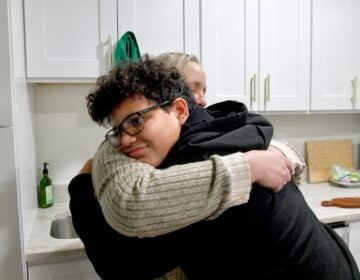A soldier’s life expressed in art exhibit in Princeton
Before Thaddeus Erdahl became an artist, he served in the military. This experience changed his life, and is reflected in Thaddeus Erdahl: Yes Sir No Sir This Way That, on view at the Anne Reid ’72 Art Gallery at Princeton Day School through January 29.
Yes Sir No Sir This Way That is “a surreal look into my time in the military – the people I knew, the things I did,” said Erdahl. It all began with a photo he found of himself at age 8, role playing a fantasy battle out in the backyard in a costume that consisted of a knitted red ski mask, ski goggles, a Viking helmet, and a shirt with a design painted by his uncle. This led to a drawing of a similar figure with a nose that protrudes like Pinocchio’s. Next is a three-dimensional interpretation with red bobbles in the hat to reference the knitted material.
There are three gunmen on the wall – they look like the evil sisters of Cinderella with nozzles for noses. These nozzles are tips of guns. “The emotional quality of the person is a hybrid weapon,” he said. The eyes have a glossy glaze, so even though these are evil characters they still evoke sympathy.
“We were trained to be elite soldiers but were treated like kids,” Erdahl said, explaining the two-and-a-half-foot-tall soldier creatures on the floor of the gallery. Like toy soldiers, they wear colorful helmets and camo pants, and carry colorful toy guns and rucksacks. “At 20 years old we could blow things up and shoot someone, but we had to ask permission to use the bathroom.”
Expressing human suffering in art
Erdahl can convey the human condition in the peeling crackle finish on a ceramic head. His portrayals of the face – simultaneously real looking and grotesque — make the physical and the psychic one. Bloodshot eyes show pain, a chin recedes into a bulging neck – these are not just physical features but they tell us who these people are. Pockmarks and drips in the glaze are remains of the suffering a character has endured.
A George Washington hairdo, an Abe Lincoln beard – who are these people? A girl in a peachy bathing cap with cheeks rouged, that same cheek bearing a crack like a scar. There’s a face with a pig’s nose, a nun with a pink mask and a rabbit up her sleeve. Some of these figures are downright frightening. And yet Thaddeus himself seems like a kid in ceramics class, too young to know the depths of pain and suffering his characters endure.
Some of the suffering is in the patina. Erdahl has lectured widely on how to create slips and under glazes to create nostalgic effects.
Telling their stories
The baggage and the stories borne by the characters come from Erdahl’s life. His uncle, a one-time member of the Hare Krishna cult, settled down to work as a waiter in Fort Lauderdale, painting on the side, before dying of AIDS-related illness in the 1990s. Erdahl’s father, a former hippy, went to work for John Deere, became a hunter, then got laid off and started a furniture restoration business in his garage. The family bought an old bank building, moved upstairs, and the furniture restoration business took over the first floor. Gradually the woodworking morphed into found object and assemblage art. Jerry Erdahl created a technique of mixing sawdust and glue to create three-dimensional elements to drawers and cabinets that look like carved wood.
“I work in ceramics but my work looks like wood,” Erdahl said. “The result is creatures with a history, like antiques, that have been loved and abused by many owners.”
Soldier becomes an artist
Erdahl, 37, an Iowa native, joined the U.S. Army in 1996. “I don’t have a good explanation for why I did it,” he said. “I didn’t know what I wanted to do.”
He recounts his parents scolding his brother for getting failing grades in college. “I didn’t want that,” he said. “I didn’t want to take the money they didn’t have.”
Based at Fort Bragg, North Carolina, he served during peace time. His platoon allowed him to do ceramic work, and he took commissions in exchange for services, such as a tattoo. “Then I went down to Fayetteville and sold my first piece in a gallery. From that moment I knew what I would do when I got out.”
He felt that serving for three years had been selfless, so he could then pursue a career in art. “I would have been too scared to have pursued art if I hadn’t done the military.”
Erdahl mines material from everyday life. He attended a Quaker meeting, not knowing what to expect. “It was quiet for a long time. I was waiting for something to happen, and at the end one gentleman stood and started talking about the economy, the war, the expansion of the universe. At the end of his 10-minute stream-of-consciousness he said, ‘I’m having a personal civil war with myself.’”
That led to Erdahl thinking about the Civil War, and so he made “Honest Abe,” with one eye bulging and covered with the pattern of the American flag. “Lincoln was a divided leader. Half the country didn’t want to follow him.”
For the duration of the exhibit, Erdahl will be working on a sculpture of a soldier in the gallery, demonstrating the mold making process and casting in plaster.
____________________________________________
The Artful Blogger is written by Ilene Dube and offers a look inside the art world of the greater Princeton area. Ilene Dube is an award-winning arts writer and editor, as well as an artist, curator and activist for the arts.
WHYY is your source for fact-based, in-depth journalism and information. As a nonprofit organization, we rely on financial support from readers like you. Please give today.









